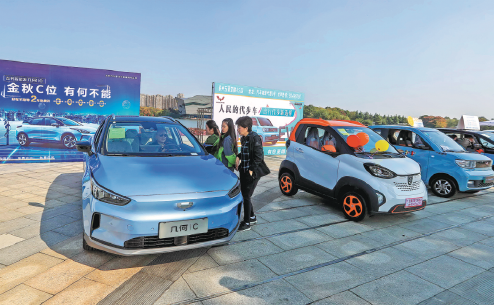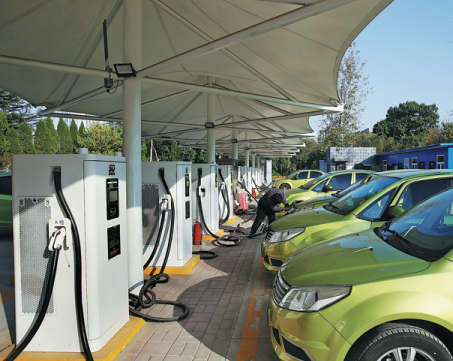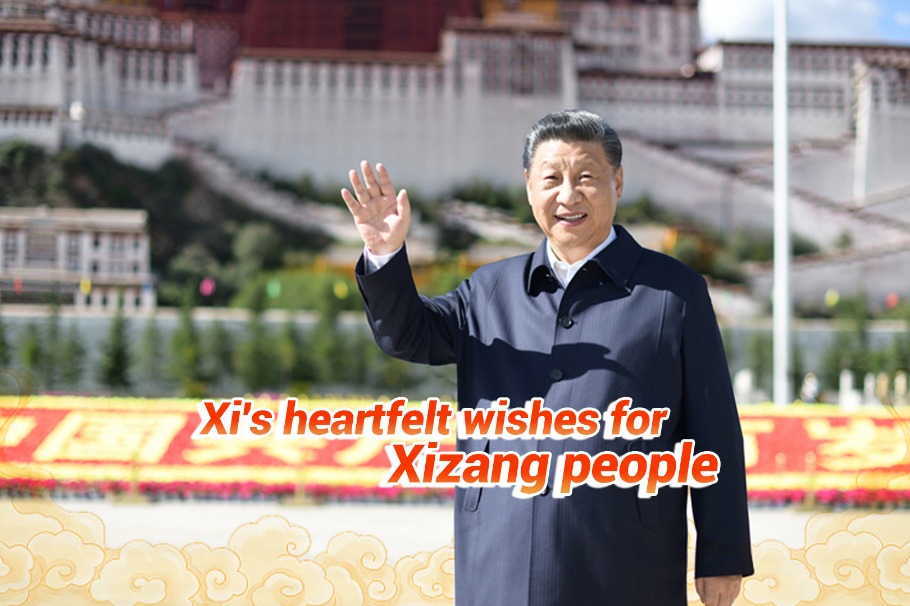'New track, new direction, endless possibilities'
Development plan to keep China's lead in e-vehicle segment of auto industry

Which type of car to buy-a new energy vehicle or a gasoline-fueled one? For a long time, Shi Tianbin, 37, a software programmer and resident of Nanjing, Jiangsu province, could not make up his mind. He was not sure if buying a relatively unconventional electric car would make long-term sense.
But what finally settled the matter was the announcement in early November of China's latest development plan for new energy vehicles, or NEVs, covering the period from 2021 to 2035.
These days, Shi is busy with sales literature of various electric car models now available in the Chinese automobile market. He said he will soon buy an NEV, which could be purely electric, gasoline-electric hybrid or fuel cell-powered.
The development blueprint that the State Council, China's Cabinet, approved envisions one NEV in every five new cars on China's streets by 2035.
Shi said: "The blueprint sent us (consumers) a clear signal that e-cars will be the future trend. Going forward, the price of an NEV will become more and more competitive. Given the country's determination to promote NEVs over the long term, I asked myself, 'Why not buy an NEV?'"
Shi is among the millions of Chinese consumers as well as automakers who are inspired by the new development plan that aims to make China a self-reliant powerhouse in the NEV sector over the next 15 years, complete with competitive technologies, strong brands and world-class quality.
Xin Guobin, vice-minister of the Ministry of Industry and Information Technology, said: "The new development plan, which follows the previous plan released in 2012, is an important guideline for the future development of the country's NEV sector.
"Amid the new round of technological revolution and industrial transformation, leading countries across the world are expected to beef up their presence in the NEV sector. China's NEV sector will embrace its rare opportunities."
The ambitious target was set after China quickly recovered from the economic effects of COVID-19. It is also in line with the proposals for drafting the 14th Five-Year Plan (2021-25), which recommended policy push to boost spending in emerging sectors, including NEVs, in coming years.
While it is well known that China is the world's largest automobile market, not so well known is the fact that the country is also the world's biggest market for NEVs.
During the 13th Five-Year Plan period (2016-20), China highlighted the role of strategic emerging industries, including clean energy and new energy vehicles. The plan called for more efforts to support the development of these new industries, in order to help China evolve into a manufacturing powerhouse.
In response, China is quickly switching gears to consolidate its lead in the NEV sector in a comprehensive manner, if industry data are any indication. Besides domestic sales, rising exports of NEVs are brightening China's image in the global e-car market.
For instance, on Oct 27, Tesla's Gigafactory in Shanghai exported 7,000 Model 3 e-car units to Belgium, from where they will be further shipped to European countries including Germany, France, Italy, Portugal and Switzerland. Ten months back, Tesla delivered the first batch of Model 3 units to the Chinese market.
At a ceremony to mark the occasion, Chen Yin, executive vice-mayor of Shanghai, said, "The China-made Tesla e-cars exported to Europe are proof of the nation's capability and competitiveness in manufacturing advanced new energy vehicles."
Agreed Zhu Xiaotong, Tesla's global vice-president and head of Greater China. He said at the event, " (This) is showcasing to the world not only the speed and efficiency of Chinese construction, but also the quality of Chinese manufacturing."
Ren Zeping, chief economist with Evergrande Group, said after 10 years of planning and development, especially during the 13th Five-Year Plan period (2016-20), the country's NEV industry has already gained certain first-mover advantages and scale advantages. A basic industrial chain and charging infrastructure have been formed, he said.
According to the China Association of Automobile Manufacturers, in September, NEV sales of 138,000 units were up almost 68 percent year-on-year and exceeded the output of 136,000 units for the month (up 48 percent).
In the first half of 2019, China's sales of new energy passenger vehicles reached 563,000, accounting for about 57 percent of the global market share, which was much higher than the 20 percent of the European Union's, said Ren.
He further said: "However, most of China's NEVs rely on domestic sales. From January to September 2019, none of the bestselling NEV models in the United States, the European Union and Japan were Chinese brands. Besides, some core components are highly dependent on imports.
"But, China has never been so close to the dream of emerging as a powerful automobile nation (in both conventional and new energy vehicle sectors).
"Government efforts (like the development plan) will have a far-reaching impact, especially when a slew of economies, including Europe, Japan and South Korea, are accelerating their efforts in electrification (of vehicles) while the e-cars of US automaker Tesla grabbed the popular imagination in China."
As global competition turned fierce, China listed five strategic tasks in its new development plan: improving technological innovation capacity; building a new type of industrial ecosystem; advancing industrial integration and development; perfecting the infrastructure system; and deepening opening-up and cooperation.
In the long run, purely electric automobiles are set to account for the majority of new cars by 2035, up from around 5 percent of the total now.
In the medium term, NEV sales are expected to account for 20 percent of overall new car sales in China by 2025. It is a new target lower than the 25 percent set in an earlier policy proposal.
Cui Dongshu, secretary-general of the China Passenger Car Association, said, "It is a more stable and scientific (medium-term) goal, following the global slowdown of the automotive industry last year and the COVID-19 pandemic, which sharpened the focus on high-quality development rather than scale development."
China's NEV development plan also set the goal of reducing the average power consumption of new purely electric passenger cars to 12 kilowatt-hours per 100 kilometers.
Cui said this showed the country's determination in developing high-end NEVs. "China no longer uses simple indicators to restrict the overall industry, but gives greater autonomy to carmakers to develop."
Such new thinking could also excite NEV owners and potential e-car buyers such as Shi. For, the ability to charge an e-vehicle quickly, cost-effectively and conveniently is important, but the relevant infrastructure, or its lack thereof, has been a source of some anxiety.
Sun Guangqi, director of the economic construction department of the Ministry of Finance, said that although the country has the largest charging network in the world, a gap exists between supply and demand.
According to official data, China had 42,000 charging stations and 1.42 million charging piles as of September. But the vehicle-to-pile ratio is only 3.1:1(that is, there is only one pile for more than three e-vehicles).
To narrow the gap, the new development plan underlined accelerated construction of NEV infrastructure and "significantly improved convenience of charging facilities" over the next 15 years.
That is important to make China self-sufficient and a potential exporter in some industry segments. For instance, in insulated gate bipolar transistors, or IGBTs, Germany, Japan and the US dominate, accounting for 34.3 percent, 7.2 percent and 24.9 percent market shares, respectively. The image processing chip sector, too, is basically a duopoly of US company Nvidia and Israel-based Mobileye, Intel's autonomous driving unit.
Hence, the new development plan highlighted that China should make significant breakthroughs in key technologies such as power batteries, drive motors and vehicle operating systems over the next few years.
To be sure, China has attracted hundreds of companies from home as well as abroad to the NEV industry, entailing investments of tens of billions of dollars in developing, designing and assembling NEVs.
For instance, it took Tesla Inc only 10 months to complete the first-phase construction of its Gigafactory in Shanghai.
Wang Hao, Tesla China's general manager, said: "A brand-new automotive era-that is, the era of NEVs-will be established. This is a new track, a new direction. It will be driven by user experience, define cars with software, and have sustainable energy as the core. There are endless possibilities in this direction."
In China, foreign NEV giants like Tesla face competition from local companies like Xpeng Motors, Nio Inc and Li Auto Inc, all of whom offer buyers a selection of models. The Xpeng P7 standard model, for instance, can travel on a single charge up to 706 kilometers in the New European Driving Cycle, which is designed to assess exhaust emission levels and fuel economy in passenger cars.
Overseas, Chinese automakers will seek to build on the current momentum. "Over the next five years, we anticipate Chinese players across the EV supply chain to aggressively enter the overseas market. We believe China material costs are lower than in the overseas market. If this advantage can sustain, China could realize a cost advantage over ex-China players," UBS analysts wrote in a note.
That should reassure aspiring e-car buyers such as Shi.



Today's Top News
- Xi attends grand gathering to celebrate Xizang autonomous region's 60th founding anniversary
- V-Day parade to unveil advanced weapons
- Intertwined economies, diverging systems
- PV industry gets ready for next phase
- Xi: Build a united, prosperous new Xizang
- China, India outline plan to address boundary question






























